As numerous studies and articles in recent years have explained, the art fair – with over 400 examples taking place around the world each year – has fundamentally changed the way galleries do business, and fairs are a fixture for exhibitors and visitors alike. In a time-poor world that is driven by convenience, the art fair forum allows access to many galleries on a single visit. Historically, Dickinson has participated at four annual fairs – TEFAF Maastricht, TEFAF New York Spring, Masterpiece, and Frieze Masters – and added a fifth, the Florence Biennale Internazionale di Antiquariato, to our lineup in 2019. Although 2020 has thus far largely been a year of virtual fairs thanks to coronavirus, we have been hearing encouraging reports about the likelihood of physical fairs resuming in the autumn. As we look ahead to the future, here are just a few of the reasons art fairs are such a vital part of the market.
Art fairs provide an unparalleled opportunity for new clients and Dickinson to meet
As pioneers in the market for private sales, Dickinson has to be discreet about many of the works we handle. We have no gallery window on the street, and many pieces are not viewable on our website, which means collectors may never know what treasures might be hiding behind our doors. Each time we take a stand at a fair, we meet new collectors, many of whom go on to become long-term clients. And even if we don’t have the right work for them at the time, these introductions often lead to mutually beneficial business further down the line, when we are able to invite new clients into our gallery to view important artworks held and offered discreetly.
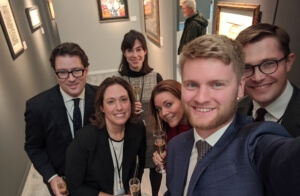

Team Dickinson enjoying a drink after a long day at Frieze Masters 2019
Art fairs provide wider publicity and outreach
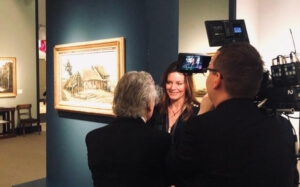

Dickinson’s Managing Director Emma Ward interviewed by the Dutch media during TEFAF Maastricht 2020
When we bring important highlights to art fairs or stage memorable themed exhibitions, the journalists want to feature our highlights, which helps clients further afield to discover us. For instance, we have brought pieces by Van Gogh to TEFAF Maastricht on six occasions, most recently in 2020 when we sold the artist’s Paysanne devant une chaumière, and each time we have received considerable attention from both buyers and the media. Similarly, we have received extensive media coverage for our themed exhibitions at Frieze Masters, including Lyrical Abstraction (2019); Formed from Nature: Barbara Hepworth (2018); Expressionism in Europe (2017); Surrealist Revolution (2016); Masters of Cubism (2015); Picasso at the Bateau Lavoir (2014); and Landscape Revisited (2013). For those clients unable to attend a fair in person due to constraints of distance or other barriers, our digital brochures, PR outreach, videos featuring specialists in conversation, and even virtual stands, do a remarkable job of capturing the ambiance of the fair in a remote environment. Fairs are able to welcome many times more visitors than even the most popular gallery exhibition, with everyone from private collectors to museum curators and trustees in attendance, making them an ideal platform for buying and selling.
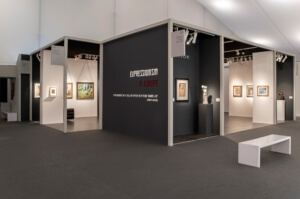

Dickinson’s presentation of Expressionism in Europe, at Frieze Masters 2017
Art fairs allow Dickinson to showcase a broad range of artworks
Although Dickinson was founded in 1993 as a specialist dealership in Old Master and British paintings, the gallery has also been handling museum-quality Impressionist, Modern and Contemporary masterpieces for over 20 years, and we tailor our art fair presentations to our audience. By presenting curated Modern stands at fairs such as Frieze Masters and TEFAF New York Spring, Dickinson is able to appeal to an audience comprised of Modern art collectors. At more traditional fairs such as TEFAF Maastricht, we are able to showcase a cross-section of our offerings, and cater to a range of collecting interests. Our vendors can be confident that we are selecting the best venue to achieve a sale on their behalf, while making sure that we have the pieces our buyers are looking for.


Dickinson’s stand at Frieze Masters 2018, recreating Barbara Hepworth’s sculpture garden at Tate St. Ives
Art fairs create competition
One benefit to selling at auction can be the sense of urgency auctions create: auctioneers are masters at playing on the drama and competition in the saleroom, urging collectors to bid before the opportunity passes them by. Vendors often cite this as an appealing reason to consign to auction, but fairs can offer a similar experience: they attract the most serious buyers, and there can be a real sense of competition to have first option on the best pieces, especially during preview days. This allows our vendors to benefit from the sense of urgency and competition, without having to sacrifice any of the control that is relinquished with an auction consignment. At the same time, art fairs do not carry the same risk of overexposure as auctions, which means that an unsold piece at a fair is not compromised the way an unsold work at auction is.
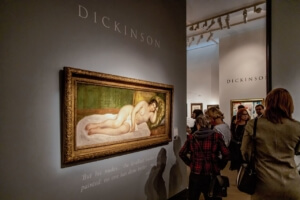

Femme nue couchée (Gabrielle), 1903, by Pierre Auguste Renoir, was sold by Dickinson at TEFAF Maastricht 2019
Art fairs promote high standards
Art fairs create an environment that encourages dealers to showcase some of their best-quality artworks that are permitted to be publically exhibited. Fairs are typically vetted by experts in each sector, including a mix of curators and members of the trade without vested interests, to ensure high quality and correct cataloguing. The high standards are also maintained by the sense of competition, with dealers aware that a mediocre work by a given artist will be quickly overshadowed by a superior example on a competitor’s stand. Galleries such as Dickinson put in considerable time and effort to stage curated, often themed stands modelled on museum-level exhibitions. Buyers benefit from the consistently high quality of the works available to buy, and the opportunity to acquire museum-quality pieces in a setting that is designed to be comfortable, convenient and luxurious. Dealers, in turn, benefit from an environment in which the collective high quality casts the best light on the pieces we have to offer.
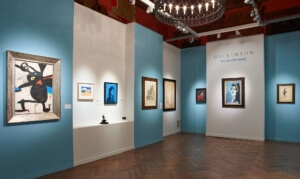

Dickinson’s stand at TEFAF New York, 2018
Art fairs offer a visible platform with a controlled setting
Once you consign a painting to auction, its fate is largely out of your control, and its fate on the day of the sale – no matter how prepared the house is – can come down to chance. It is a gamble, which sometimes pays off, but often does not. We regularly read about successes and records set at auctions but rarely about the many disappointments: lots sold on the reserve or not at all, or withdrawn at the last minute to avoid a negative record of being ‘bought in’. It is, in a sense, a ‘one shot chance’.
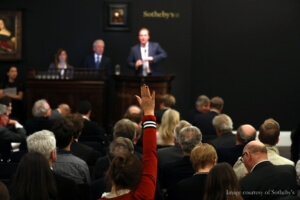

Dickinson’s Managing Director Emma Ward bidding during a Sotheby’s Old Masters Evening Sale
Art fairs, on the other hand, allow vendors a greater deal of control, as the ultimate decision to accept or reject an offer is up to them once we communicate it. We are able to disclose whether an offer comes from a new or established private collector, an adviser, an institution or even another dealer, in order to help facilitate a fully-informed decision. For buyers, fairs offer the unparalleled opportunity to view the holdings of multiple galleries in a single venue, and in an increasingly transparent context: more and more, galleries are posting prices on their labels and disclosing their commission structure, a practice Dickinson has long followed and championed. This fosters a sense of openness and we find that, rather than discouraging conversation, it leads to a more open and productive dialogue.
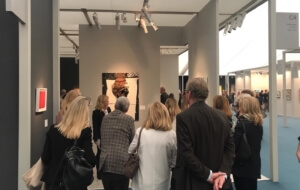

A group of visitors on Dickinson’s stand at Frieze Masters 2019
The nature of the art market is changing and fairs have become a vital part of the way galleries do business. We look forward to seeing you on our stand at a future fair!


